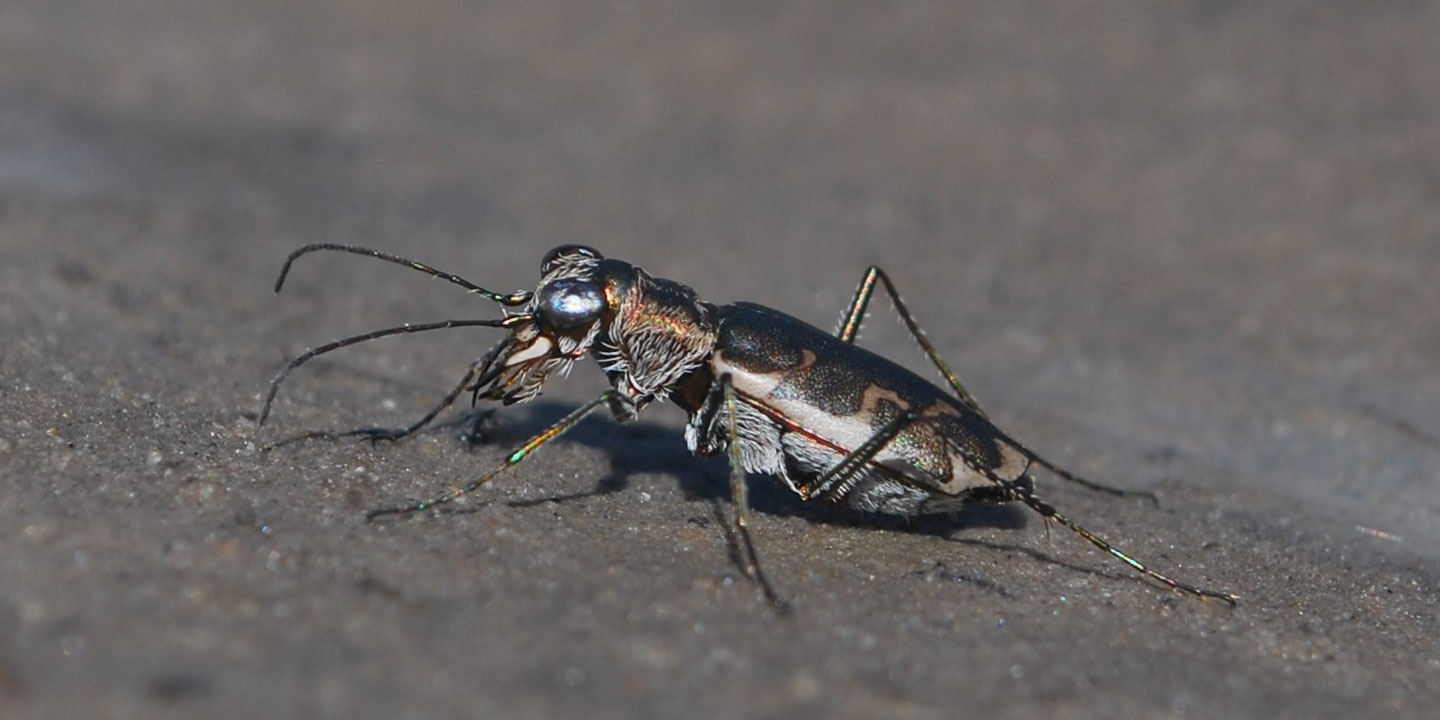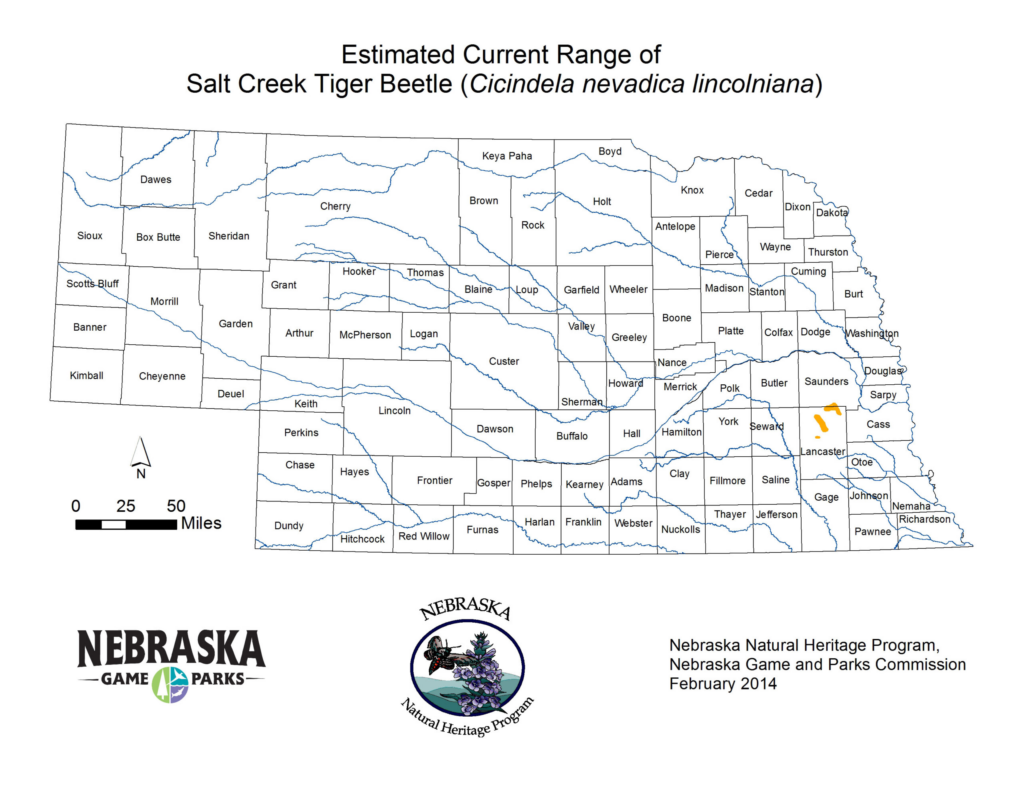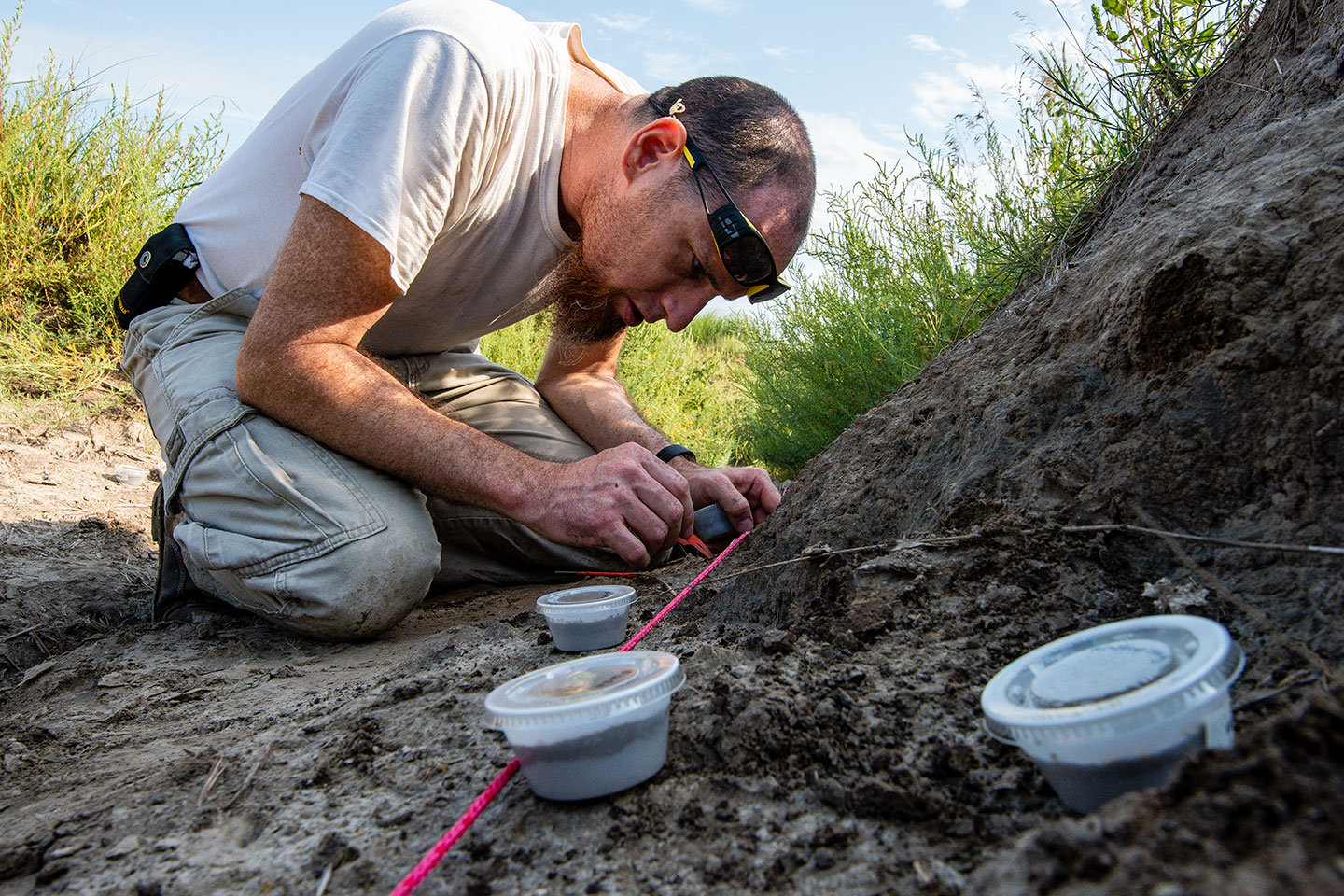Salt Creek tiger beetle
Status: Endangered

The Salt Creek tiger beetle is one of the world’s rarest insects and is listed as an endangered species. It is known to occur only in Lancaster and Saunders Counties in Nebraska, just north of Lincoln.
Although the Salt Creek tiger beetle spends most of its life as a larva, it is usually observed in its adult stage, because larvae live underground. The larvae are soft-bodied and caterpillar-like in appearance with large, dark heads and large mandibles for feeding on prey. Male and female beetle adults are about a half-inch long. They are metallic brown to dark, olive green along their top side and have a metallic green on the underside. Adult beetles have sickle-shaped mandibles for catching their prey.
Range
The beetle is currently found at a few sites in Lancaster County, in areas where suitable saline wetland habitat remains. Historically, the extent of the Salt Creek tiger beetle habitat covered large areas in Lancaster and southern Saunders counties. These wetlands were once so extensive that J.P. Morton, of the Morton Salt Company, tried mining salt from the area. However, since the late 1880’s, these saline wetlands have primarily been lost to the development of Lincoln, the construction of levees, straightening of nearby stream channels for flood control, and draining and filling for various purposes.
One of the most significant impacts to Salt Creek tiger beetle habitat is stream channelization. Stream straightening results in higher water velocities, which contributes to a lowering of the Salt Creek stream bed. Because water flows to the lowest point, the lower stream bed begins to drain the nearby wetlands which leads to the drying and loss of wetland habitat. Presently, there are less than 15 acres of suitable Salt Creek tiger beetle habitat remaining (or about 15 football fields). Other species that depend on Nebraska’s saline wetlands have also declined with the decline of these wetlands.

Diet
Salt Creek tiger beetles are carnivorous insects. As larvae, Salt Creek tiger beetles remain idle near the top of their burrows and ambush any small insect that passes near the burrow opening in a tiger-like fashion. The larvae pull the captured prey into their burrow and feed. Adult tiger beetles are also predaceous and capture various insects and spiders for feeding. Adult tiger beetles are sight predators meaning they use sight (not sound or touch) to hunt. They move with extremely fast bursts of speed to catch prey.
Habitat
The Salt Creek tiger beetle requires saline mud flats and exposed mud banks with salt deposits within saline wetlands and along stream edges for foraging, feeding, reproduction, and overwintering. Salt Creek tiger beetles depend on the presence of moist, muddy areas and are most often found within a few feet of a stream or wetland edge. Other tiger beetle species found in Nebraska’s saline wetlands are more tolerant of drier conditions.
The salt deposits upon which the Salt Creek tiger beetle depends are remnants of a former inland sea that once covered Nebraska. The beetle has declined with the loss of Nebraska’s saline wetlands, which are important for the beetle and other wildlife, including more than 200 species of migratory birds and saltwort, an endangered plant in Nebraska. Like all types of wetlands, saline wetlands are important for maintaining good water quality and flood control.
Reproduction
Like most insects, the Salt Creek tiger beetle undergoes complete metamorphosis as part of its life cycle; stages include egg, larva, pupa, and adult. The beetle has a two-year life cycle, spending two years as a larva and six weeks as an adult in its second year. During its short adult life, adult Salt Creek tiger beetles spend most of their time reproducing. Adult beetles are active between late-May and mid-July, with peak numbers in mid to late June.
After mating, male beetles will ride atop the female to prevent other males from mating with her. Female beetles lay eggs one at a time in moist soil, and when the larvae hatch, each individual constructs its own burrow for feeding, shelter, and overwintering. Salt Creek tiger beetle larvae will seal off their burrows during stressful conditions, such as extremely hot or dry weather or large rain events. Larvae build a side chamber to their burrows for pupating, and remain in their chambers until adults emergence.
Population status
In 2012, University of Nebraska-Lincoln researchers counted 374 adult Salt Creek tiger beetles. The most beetles counted since 1991, when intensive surveys began, was 777 individuals in 2002. The fewest beetles counted was 153 in 2005. All of these beetles are confined to just three areas north of Lincoln. There were six different beetle populations in 1991, but populations at three of these sites have since died off.
Management and outlook
Several efforts have been made since the 1990’s to actively manage, restore and protect saline wetlands for the benefit of the Salt Creek tiger beetle in Lancaster County. Although habitat has been greatly reduced from historic levels, much of what remains is protected from development.
Conservation partnerships, such as the Eastern Saline Wetlands Partnership, have been extremely effective at conserving saline wetland habitat through land acquisition.
There are ongoing efforts to raise beetles in captivity at Omaha’s Henry Doorly Zoo and Lincoln’s Children’s Zoo. These beetles will periodically be released into areas where the beetle was once found to help increase the number of beetles in the wild. Ongoing conservation work includes habitat improvement projects for the benefit of the beetle.
Entomologists will continue to conduct annual surveys for the beetle to monitor the status and health of the remaining populations. Education efforts are underway to engage Nebraska students and the public. The public can access saline wetlands for wildlife viewing and read about the importance of saline wetlands.
Conservation help
Learning about the Salt Creek tiger beetle and saline wetlands is an excellent way to gain appreciation for this unique insect. Additionally, individuals can donate to conservation organizations dedicated to conserving Salt Creek Tiger Beetle habitat.
Landowners near Salt Creek tiger beetle habitat should take care to avoid pollution run-off from entering the saline wetlands.
References
Spomer, S. and L. Higley. 2001. The Salt Creek Tiger Beetle. Bio-graphica International. http://drshigley.com/lgh/sctb/default.htm.
Harms, R. 2009. Recovery Outline for the Salt Creek tiger beetle (Cicindelanevadicalincolniana). http://www.fws.gov/mountain-prairie/species/invertebrates/saltcreektiger/FinalRecoveryOutlineFeb2009.pdf.




